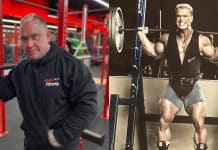
The seated dumbbell calf raise protects your knee joints.
The seated calf raise primarily targets the soleus muscle instead of the gastrocnemius in the calves. Both muscles are essential, but strengthening the soleus prevents non-contact ACL tears since it supports the anterior cruciate ligament as an agonist (1). This exercise is an outstanding routine for enhancing the strength and resilience of your calves and legs.
Several variations of the seated calf raise exist, including the machine, barbell, and kettlebell versions. However, this guide focuses specifically on the seated dumbbell calf raise. It’s common to find the seated calf raise machine occupied at the gym. As a viable alternative, the seated dumbbell calf raise offers comparable benefits and results.
This guide demonstrates how to perform this exercise using dumbbells. It delves into the techniques, the specific muscle groups targeted, and the benefits of the seated dumbbell calf raise. Additionally, this guide provides valuable options for those seeking alternative routines to enhance muscle growth.
Techniques & Muscles Worked
The seated dumbbell calf raise removes the upper body from the equation. This routine involves only the lower body and its muscles. When done right, this exercise explicitly targets the soleus muscles in your calves.
The seated dumbbell calf raise is a convenient alternative to the machine seated calf raise. Since dumbbells and weight plates are the major equipment you need, you can perform it anywhere. Below are step-by-step instructions you can follow to do this exercise in the correct form.
- Place the weight plates in front of the bench and grab the dumbbells.
- Sit on the bench with your legs about a foot from the weight plates. Then, using a neutral grip, place the dumbbells on your thighs, just close to your knees.
- Make sure your lower and upper legs are straight when seated. Your back should be equally straight, with your shoulders slightly taken back. This is your starting position.
- Slowly raise your heels as high as possible off the ground. This lifts the dumbbells on your thighs. Ensure that your back remains straight.
- At the top position, pause for a few seconds, then lower your heels back to return to the starting position and complete the rep.
- Repeat for as many reps as you desire.
Benefits
The seated calf raise is an effective leg day routine that can improve your overall balance. It also helps you prevent injuries and tears. Below are more benefits of this exercise.
Bigger Calves & Legs
The seated calf raise is an isolation exercise that targets your lower leg muscles. If you want to build your calves, this exercise is perfect. Using the dumbbell as resistance helps to introduce a load, leading to muscle hypertrophy.
Reduces Injury Risk
Strengthening your soleus muscle allows it to handle much force or load. This is important for bodybuilders that lift and handle extra weights. As aforementioned, this can help you avoid non-contact ACL tears.
Simple to Do
The seated dumbbell calf raise is a simple exercise to learn and perform. All you have to do is get the proper form and technique. This routine can benefit beginners, intermediate, and advanced athletes.
Better Balance
This exercise mainly targets the soleus muscle. It reinforces and strengthens it, allowing it to adequately handle forces from the ankle joints. Seated dumbbell calf raises can also increase mobility and range of motion.
Improved Athletic Performance
The calf muscle consists of two muscles: the gastrocnemius and the soleus. These two muscles work together for explosive movements. Doing the seated dumbbell calf raise correctly helps increase your performance by building your soleus.
Seated Dumbbell Calf Raise Alternatives
Seated dumbbell calf raise is a great way to train your calves. However, there are other options for effective muscle growth and maximum gains. This study shows that athletes should integrate other training techniques to avoid training monotony and plateau (2). Below are some alternative routines that are great for your calves.
Tiptoe Farmer’s Walk
The tiptoe farmer’s walk is a functional exercise that targets your calves. You need two dumbbells to do this routine. When walking, ensure that your knees are slightly bent for maximum gains.
Box Jump
The box jump is an effective calf-building exercise for fitness enthusiasts and bodybuilders. This exercise also works on your power development, increasing your explosive strength. This bodyweight exercise only requires a box and adequate space for jumping.
Calf Jump
The calf jump is another excellent isolation exercise for your calves. You can do this routine unilaterally to help you find and fix any strength imbalances between your legs. Calf jumps are a great finishing routine for a leg training day.
FAQs
Are seated dumbbell calf raises effective?
Yes, seated dumbbell calf raises are effective. They work on your lower legs and increase explosiveness and power.
How do you do sitting calf raises with dumbbells?
When doing sitting calf raises with dumbbells, ensure you position the dumbbells on your thighs, just close to your knees. Your back and legs should also be straight for proper form. For more insights, check the exercise guide above.
Do seated calf raises make the calves bigger?
Doing a seated dumbbell calf raise will make your calves bigger. It also gives your legs more balance, allowing you to lift heavy objects without potential injury.
Follow us on Instagram, Facebook, and Twitter for more exercise guides!
References
- Elias, J. J., Faust, A. F., Chu, Y. H., Chao, E. Y., & Cosgarea, A. J. (2003). The soleus muscle acts as an agonist for the anterior cruciate ligament. An in vitro experimental study. The American journal of sports medicine, 31(2), 241–246. https://doi.org/10.1177/03635465030310021401
- Krzysztofik, M., Wilk, M., Wojdała, G., & Gołaś, A. (2019). Maximizing Muscle Hypertrophy: A Systematic Review of Advanced Resistance Training Techniques and Methods. International journal of environmental research and public health, 16(24), 4897. https://doi.org/10.3390/ijerph16244897















